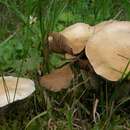pt-BR
nomes no trilho de navegação


Hebeloma is a genus of fungi in the family Hymenogastraceae.[1] Found worldwide, it contains the poison pie or fairy cakes (Hebeloma crustuliniforme) and the ghoul fungus (H. aminophilum), from Western Australia, which grows on rotting animal remains.
The generic name is a compound Ancient Greek word hēbē (ἥβη), "youth" or "puberty" and the suffix -loma (λόμα), a fringe (pertaining to the fungal veil). Thus, Hebeloma translates as "fringe of youth", in reference to how the fungal veil is only seen in immature specimens.[2]
The placement of the genus Hebeloma within the fungal taxonomic tree has varied over time. Historically it has been most often placed in the order Agaricales but was placed Cortinariales in the 8th edition of the Dictionary of the Fungi. The most recent inter-generic placement (Knudsen & Vesterholt, 2nd ed, 2012)) places it the family Hymenogastraceae within Agaricales.[3]
Hebeloma is a genus of fungi in the family Hymenogastraceae. Found worldwide, it contains the poison pie or fairy cakes (Hebeloma crustuliniforme) and the ghoul fungus (H. aminophilum), from Western Australia, which grows on rotting animal remains.
Hebeloma es un género de hongos. De distribución cosmopolita, contiene las especies (Hebeloma crustuliniforme) y (Hebeloma aminophilum), de Australia Occidental , que crece en la putrefacción de restos de animales.
El nombre genérico se compone de la palabra del antiguo griego Hebe, "juventud" o "pubertad", y el sufijo - loma , "una franja" (perteneciente al hongo velo ). Por lo tanto, Hebeloma se traduce como "velo juvenil", en referencia a la forma del velo de los hongos que sólo se ve en las muestras inmaduras.[1]
Tiene un sombrero de hasta 12 cm, muy aplanado de madura. Su cutícula lisa y glabra (sin pelo), separable. El color variable de blanco a pardo claro o rojizo, más oscuro en el centro. Láminas escotadas o casi libres, con lamélulas, no lacrimosas, color beige o café con leche.
Su pie es muy largo (6-15 cm), algo bulboso en la base, curvado, fibroso y blanquecino. Tiene la carne blanca que se tuesta ligeramente al corte. Huele a rábano cuando es pequeño.
To acapara muchi interès culinario porquè tiene un sabor amargo desagradable, y puede ser tòxico.
Hebeloma es un género de hongos. De distribución cosmopolita, contiene las especies (Hebeloma crustuliniforme) y (Hebeloma aminophilum), de Australia Occidental , que crece en la putrefacción de restos de animales.
Hebeloma[1],[2],[3],[4],[5] (nom normalisé français : les Hébélomes) est un genre de champignons basidiomycètes lamellés (Agaricales) de la famille des Hymenogastraceae. Proche des Cortinaires, au chapeau nu, crème, café-au-lait à brun, et au pied parfois annelé ou cortiné. Aucun n'est comestible, certains peuvent causer de graves intoxications.
Assez facile à reconnaître en tant que genre à son chapeau typiquement visqueux, ses lames ocracées, ni libres ni décurrentes, à liseré marginal blanchâtre, cortine souvent fugace, rarement persistante[6], il s'avère très difficile à déterminer au niveau spécifique sur le terrain. Il réunit un nombre croissant d'espèces depuis le début du siècle, de 90 en 1994, à environ 150 espèces en 2008 et en janvier 2016, Index Fungorum admet 321 espèces dans le genre Hebeloma[7] à silhouette Collybio-tricholomoïde, chapeau obtus ou convexe étalé, souvent terne, à odeur raphanoïde, terreuse ou chocolatée. Sporée ocre terne. Spores en forme d'amandes, verruculeuses.
Traditionnellement classé dans la famille des Cortinariaceae, puis dans les Bolbitiaceae et enfin dans les Hymenogastraceae ou Strophariaceae. Quelques-unes sont très courantes, notamment l'Hébélome moutarde (Hebeloma sinapizans), (Hebeloma crustuliniforme). L'espèce type est Hebeloma fastibile.
En pépinière, il a été démontré que leur association mycorhizienne avec certains arbres favorise très fortement la croissance de ces derniers[8],[9].
Hébélome (1874) est le nom francisé à partir du latin mycologique Hebeloma, composé du grec ancien ἥβη, hếbê « jeunesse, puberté (donc pilosité ») et λῶμα, lôma (« frange, bordure, lèvre, ourlet »), soit « à bord pubescent » (et non pas « frangé ») en référence à leur marge souvent duveteuse, dite « pubescente »[10],[11].
Autre interprétation, beaucoup plus probable : « voilé dans la jeunesse »[12].
Hebeloma,,,, (nom normalisé français : les Hébélomes) est un genre de champignons basidiomycètes lamellés (Agaricales) de la famille des Hymenogastraceae. Proche des Cortinaires, au chapeau nu, crème, café-au-lait à brun, et au pied parfois annelé ou cortiné. Aucun n'est comestible, certains peuvent causer de graves intoxications.
Assez facile à reconnaître en tant que genre à son chapeau typiquement visqueux, ses lames ocracées, ni libres ni décurrentes, à liseré marginal blanchâtre, cortine souvent fugace, rarement persistante, il s'avère très difficile à déterminer au niveau spécifique sur le terrain. Il réunit un nombre croissant d'espèces depuis le début du siècle, de 90 en 1994, à environ 150 espèces en 2008 et en janvier 2016, Index Fungorum admet 321 espèces dans le genre Hebeloma à silhouette Collybio-tricholomoïde, chapeau obtus ou convexe étalé, souvent terne, à odeur raphanoïde, terreuse ou chocolatée. Sporée ocre terne. Spores en forme d'amandes, verruculeuses.
Traditionnellement classé dans la famille des Cortinariaceae, puis dans les Bolbitiaceae et enfin dans les Hymenogastraceae ou Strophariaceae. Quelques-unes sont très courantes, notamment l'Hébélome moutarde (Hebeloma sinapizans), (Hebeloma crustuliniforme). L'espèce type est Hebeloma fastibile.
En pépinière, il a été démontré que leur association mycorhizienne avec certains arbres favorise très fortement la croissance de ces derniers,.
Hebeloma (Fr.) P. Kumm., Führer für Pilzfreunde (Zwickau): 22, 80 (1871) è un genere di funghi con le seguenti caratteristiche.
Carnoso, confluente col gambo con margine incurvato da giovane.
Fitte, sinuose, color bianco sporco oppure ocra.
Fibrilloso, sodo. Velo fugace o persistente in anello.
Ocracee oppure bruno-ferruginee in massa, ovoidali, verrucose, senza veri cistidi.
Trascurabile. Molte le specie non eduli, alcune velenose (es. H. sinapizans), poche quelle commestibili che tra l'altro sono di qualità mediocre.
La specie tipo è Hebeloma fastibile (Pers.) P. Kumm. [as 'fastibilis'] (1871), altre specie sono:
Hebeloma (Fr.) P. Kumm., Führer für Pilzfreunde (Zwickau): 22, 80 (1871) è un genere di funghi con le seguenti caratteristiche.
Jaunabudė (lot. Hebeloma) – nuosėdinių (Cortinariaceae) šeimos grybų gentis.
Lietuvoje auga: